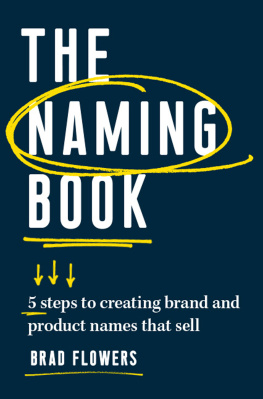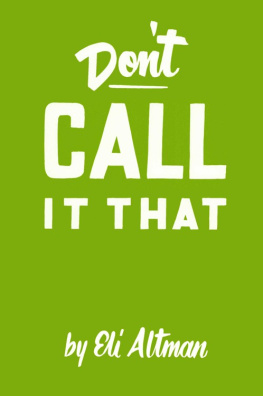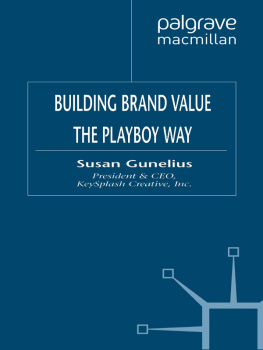
The book was easy to follow and understand. I was able to engage with the workbook-type format and follow the steps to create a name for my business. There are many little tips and techniques that, honestly, most of us never think about. Interestingly though, once you learn them, youll have a better idea of why some iconic brands have such great names. A perfect book for those considering new business ventures or rebranding with a name change.
DAVE SEVIGNY, SERIAL ENTREPRENEUR AND FOUNDER OF VOLTA TECHNOLOGY
Weve partnered with Brad and his team to name several products. A good name is critical at every stage, from getting early traction to scaling a business. Brad was incredible at coming up with a wide array of candidates and then thinking through the journey of each option.
ANDREW BOROVSKY, HEAD OF PRODUCT, CADRE
My favorite part of the process was that the team first took the time to understand our company culture and values. From there, we received distinct concepts that were diverse and aligned with different aspects of our culture. The end result was natural, authentic, and memorable. It inspired our employees.
TAYLOR AMERMAN, GLOBAL ALCOHOL RESPONSIBILITY MANAGER, BROWN-FORMAN
I used The Naming Book to help me name my new business. I was a complete newbie and had no idea where to start. I worked through the exercises in the book with the help of friends and family. One night when we were putting different words together as instructed by the book, we came upon the perfect name. Every time I started to feel overwhelmed and frustrated by the process, I went back and did another exercise until I landed on the right name. Having the steps clearly laid out made the process so much easier.
HELEN NONN, ENTREPRENEUR, WOVEN WONDER
As my clients start the branding process with me, they often realize that in addition to a new visual identity, the companys name needs to be updated. Guiding them through these naming exercises helps me develop a new brand that is more accurate and reflective of the companys mission and personality.
STEVIE MORRISON, ENTREPRENEUR AND GRAPHIC DESIGNER
Entrepreneur Press, Publisher
Cover Design: Andrew Welyczko
Production and Composition: Eliot House Productions
2020 by Entrepreneur Media, Inc.
All rights reserved.
Reproduction or translation of any part of this work beyond that permitted by Section 107 or 108 of the 1976 United States Copyright Act without permission of the copyright owner is unlawful. Requests for permission or further information should be addressed Entrepreneur Media Inc. Attn: Legal Department, 18061 Fitch, Irvine, CA 92614.
This publication is designed to provide accurate and authoritative information in regard to the subject matter covered. It is sold with the understanding that the publisher is not engaged in rendering legal, accounting, or other professional services. If legal advice or other expert assistance is required, the services of a competent professional person should be sought.
Entrepreneur Press is a registered trademark of Entrepreneur Media, Inc.
ebook ISBN: 978-1-61308-423-6
Choosing a name is like driving a racing car.
To win, you have to take chances!
Al Ries and Jack Trout,
Positioning: The Battle for Your Mind
CONTENTS
INTRODUCTION
George Vancouver spent nearly as much of his life on the water as on land. He was born in the middle of the eighteenth century, at the height of European exploration, in a port town north of London. At the age of 13, he volunteered for the Royal Navy and went to sea.
He was taken on as an apprentice by Captain James Cook and was onboard for the mapping of the east coast of Australia and the circumnavigation of New Zealand, a voyage that lasted three years. During the same timespan when I went from starting puberty to my first school dance to driving a car, he hardly set foot off the boat. He liked it enough to do it again right away. This time, he was gone for four years. At his age, I was playing high school baseball, graduating, and going off to college. Vancouver was still on a boat.
His dedication paid off, though. Before the age of 40, he was made a captain of the Royal Navy and tasked with finding the Northwest Passage, a long-sought-after route connecting the Pacific and Atlantic Oceans by sailing through the Canadian Arctic. If he could find it, the results would be lucrative for British trade. Since he was going the long way around anyway, he started off exploring the Pacific islands. He then went on to San Francisco and proceeded north.
In addition to exploring, he was also tasked with creating maps of the Pacific coast. He eventually concluded that there was no Northwest Passage, but he did make some valuable discoveries. He also left his mark on the geography of the Pacific Northwest. The most notable part of the expedition was the mapping of the Inside Passage from Seattle to Alaska. In fact, creating these maps became a big part of Vancouvers legacy.
Captain Vancouver was a well-trained cartographer. He could certainly manage his ship and crew. He was not, however, prepared for all the naming he was about to do. At that time, mapping meant he would need new names for the places he encountered on his journey. He likely didnt have the criteria to decide if a name was good. He didnt have any tools to generate ideas. And his research tools onboard were severely limited.
Once they moved into the Inside Passage, the captain and his crew discovered a large island, and (no surprises here) he named it Vancouver Island. His names didnt get much more creative than that, unfortunately, even though they persist more than 200 years later. What could have been a master class in memorable naming reads more like a laundry list.
He sprinkled in some benefactors and a few significant naval names, and then quickly ran out of steam. Eddies, whirlpools, inlets, and straits were a roll call of everyone and anything he had ever known. In his classic book, Vancouvers Discovery of Puget Sound, Edmond Meany identifies these examples of Captain Vancouvers lackluster naming conventions:
+ Puget Sound. Named after his lieutenant, Peter Puget.
+ Port Gardner. Named after his colleague, Vice Admiral Sir Alan Gardner.
+ Port Susan. Named after Gardners wife, Susanna.
+ Mount St. Helens. Named after his friend the Baron St. Helens.
+ Mount Rainier. Named after his colleague and friend Rear Admiral Peter Rainier.
+ Mount Baker. Named after the guy who first saw it, James Baker.
+ Whidbey Island. Named after explorer Joseph Whidbey.
+ Vashon Island. Named after a colleague, Captain James Vashon.
Given the amount of time Captain Vancouver spent on a boat in his life, these names arent surprising. Of course he would name things after other explorers, his fellow sailors, and other people he knew. He pulled liberally from the names around him. The starkest example of this is the name of his ship, HMS Discovery. He didnt choose his ships name, but he did name four different places after it. There is a Discovery Bay, Discovery Passage, Discovery Island, and Port Discovery.
Next page












